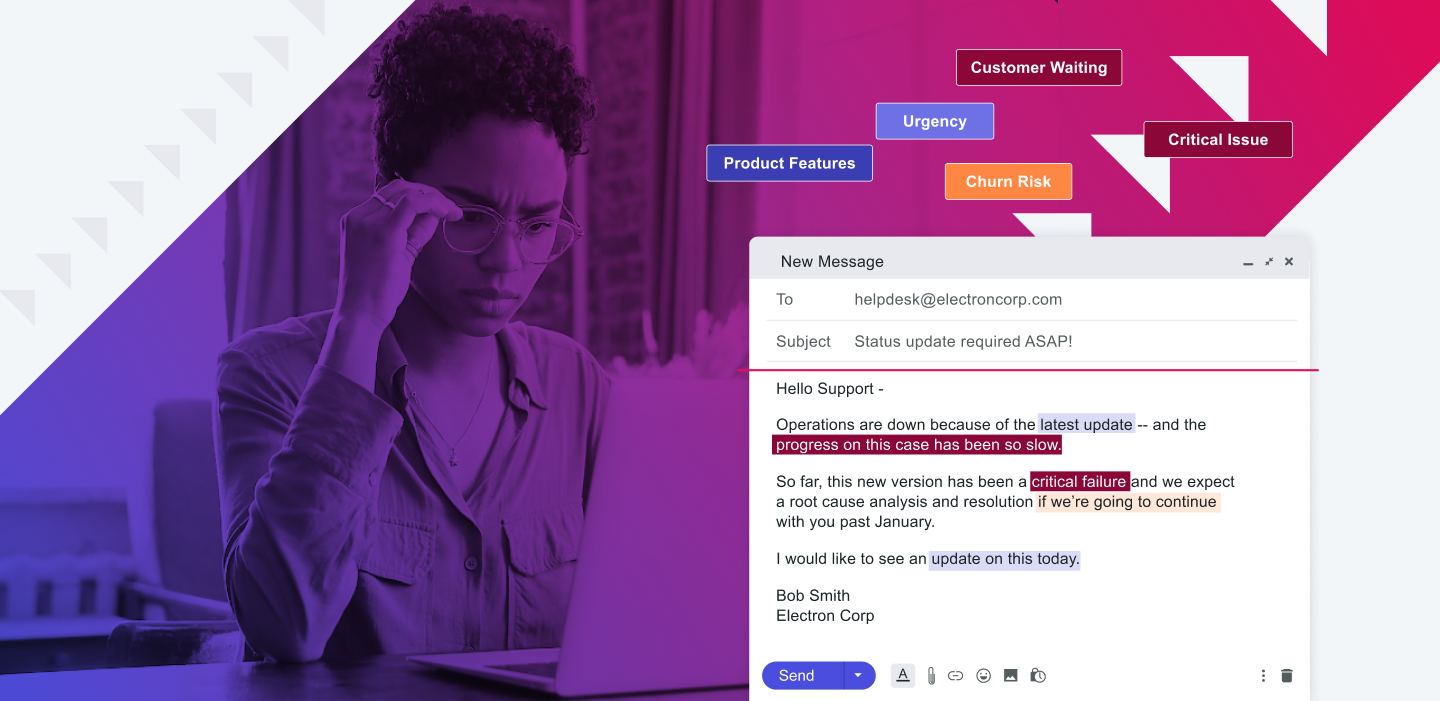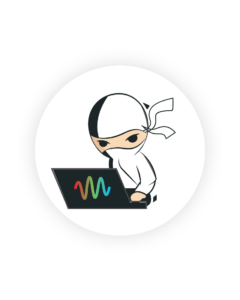
Sep 5, 2023
Text Analytics: What It Is and How It Improves Customer Support
sentiment analysispredictive analytics
Text analysis, whether applied to email, chat, or SMS messaging, is the DNA of what makes the best AI-powered customer support platforms work. When harnessed to their fullest, they can reduce frustration for customers and agents. They also unlock potential future sales and service opportunities that may otherwise go unnoticed.
What is text analytics?
Text analytics is a technology application that considers large volumes of unstructured text to find trends, patterns, or insights. It uses artificial intelligence (AI), machine learning algorithms, and natural language processing (NLP) to look for intent, anticipate what the writer of the text may need, and then offer suggestions or next steps for the reader to act appropriately. In the case of SupportLogic’s technology, it often detects important messages of frustration, impatience, or confusion without them being stated directly by a customer. The clues are in the text patterns detected by the AI when compared to other customers who have used similar language.
It’s not just about identifying trends with customers, however. It also works to detect sentiment in the messages sent from customer support agents to identify quality assurance, training, and process improvement opportunities.
“SupportLogic can look at every interaction that happens between the customer and the agent,” says Deepak Lakshmanan, a senior product manager at SupportLogic. “Many of the signals and a lot of insights can be gleaned just by monitoring the comments passed between the customer and the agent without waiting for the customer to explicitly state that they are frustrated, for example.”
How does it work?
Text analytics doesn’t work in a vacuum. In fact, it uses a one- to two-year history of text-based conversations with customers, which it scans to identify patterns. Then, it uses prediction models to anticipate what the customer may want and how the agent or team member can best solve any issues.
It cuts through the noise of a traditional back-and-forth customer support conversation and focuses on those signals that have historically led to certain case outcomes. It helps support managers to proactively monitor cases and identify those that are at risk of escalation.
Text analytics tools perform the following tasks for customer interactions:
- Sentiment analysis by extracting negative and positive sentiments
- Signal detection and extraction of follow-up, call requests, churn risk, and more
- Keyword extraction to provide additional insights on the skills needed for solving an issue so the right agent is assigned to the case
Once signals are extracted, they get fed into an escalation prediction model to identify cases most likely to be escalated in real time. They also contribute to an overall Account Health Score (AHS).
Sentiment analysis can help identify opportunities to better support customers by detecting:
- Frustration: Is the customer using words or phrases that historically lead to frustration? Is this a situation that could be resolved before the customer gets to that point?
- Urgency: Is the frequency of messages, tone, or words used indicative of a customer’s impatience or need to speed things along?
- Product issues: Is the problem something that’s linked to a product flaw or lack of knowledge about how to use the product? Would the customer be better supported by an engineer, developer, or someone in tech support instead of standard customer support?
- Requests for escalation or threat of cancellation: Text analytics can pick up on and flag these conversations, so these most urgent tickets can be prioritized and given to the agents with the most experience turning things around. Sometimes, words aren’t always explicitly stated, but text analytics can pick up on other related signals and prompt a proactive outreach from support ahead of time.
- Requests for face-to-face meetings: Customers may ask for someone to call them or get on a Zoom, but are your agents actually making time for this? By tracking every ticket and looking for just these opportunities, agents won’t have to keep tabs on every ticket, and these types of requests can get flagged for follow-up by management instead of falling by the wayside.
“There is the capability in our product for the manager to set up alerts, so when a frustration signal is detected, they can get notified instantly through Slack, emails, or SMS messages,” explains Lakshmanan.
Text analytics through the support case lifecycle
Text analytics helps improve overall customer health throughout the stages of a support ticket.
Brand new cases
Just because it’s a customer’s first outreach to support, it doesn’t mean there’s no data to work from. SupportLogic’s text analytics technology looks for signals in the messaging that years of past text data from other customers have identified as important, then helps prioritize that case based on escalation risk factors.
Ongoing cases
As a customer continues to call back in and check on the status of a case, text analytics monitors for signals of frustration from both the customer and the agent. Potential problem cases can be flagged for management to step in and help resolve them as needed.
Resolved cases
When a case is closed, it isn’t done. Text analytics keeps a record of the conversation to use for future case analysis and quality assurance needs. It works to make the machine learning model better. Individual cases may also be flagged for potential outreach and upsell opportunities.
4 use cases of text analytics in customer support
Let’s look at several applications of text analytics that create better outcomes for support teams and customers:
- Analyzing customer interactions via text, chat, or email to measure sentiment: AI scans each piece of text, compares it to thousands of previous case histories, and determines if a customer may be feeling something they aren’t saying explicitly. It picks up on hints of frustration, confusion, or excitement, for example.
- Identifying and addressing common customer issues: Analytics identifies trends in customer cases, then determines if it’s likely to be a product, service, or education issue. Frustration over a security patch would be an issue for developers to solve; not knowing how to use a product is a matter of marketing.
- Predicting and preventing potential escalations: The signals often indicate the need for a proactive resolution with a support agent that has the authority to take action on an account. This reduces several front-line conversations and may even preempt the dreaded request to “speak to a manager.”
- Reducing response time and improving customer satisfaction: Analytics can approach those important KPIs head-on, especially those where you traditionally struggle. With better response times, agent solutions, and escalation management in place, KPI goals are now within reach.
Benefits for customer support teams
While helping the customer is the ultimate goal, text analytics, when used appropriately, offers an excellent ROI from a company-wide perspective, including:
- A more pleasant work environment where support agents deal with less frustrated customers and have the tools available to resolve cases quickly. This can lead to a better sense of corporate pride and less overall agent churn.
- A better brand reputation, as your agents are seen as helpful, proactive, and able to assist even those customers who aren’t quite able to identify what they need.
- Potential sales increase as happy customers are more likely to buy, and analytics can identify opportunities to upsell when appropriate.
- Better use of company resources, as analytics helps identify the right person for the job in each support case, as well as the appropriate next steps.
Set up your customer support teams for success
While excellent customer support may help your customer forgive a lackluster product experience, it’s hard to undo the damage of a truly frustrating support interaction. Text analytics software, like the engine behind SupportLogic’s platform, helps you read between the lines, manage cases proactively, and deliver a better customer experience across the board.
Consider how it worked for Coveo, an AI-powered relevance platform that experienced a 31% increase in First Day Resolution and a 56% reduction in escalation requests within the first six months of using SupportLogic technology.
Don’t miss what your customer is trying to tell you. Get a guided tour of SupportLogic’s powerful text analytics technology, or try a free demo to test it out for yourself.
Don’t miss out
Want the latest B2B Support, AI and ML blogs delivered straight to your inbox?




